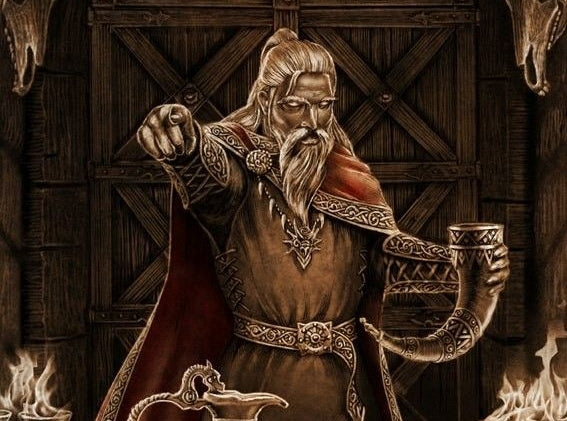Forseti is mentioned only twice in Old Norse literature. The first mention comes from the 15th stanza of the Grímnismál, one of the poems in the Poetic Edda. There, it’s said that Forseti’s dwelling-place, Glitnir, is a resplendent hall made of gold and silver, and that he settles disputes.
He thus seems to be the divine equivalent of and model for the human “lawspeaker” (lögsögumaðr), the ceremonial head of the þing, the Scandinavian legal assembly. The lawspeaker often acted as a judge who decided the outcome of disputes in accordance with the law.

Lawspeaker, Saga Museum
That’s the extent of reliable, relatively unambiguous information concerning Forseti that we have from any primary source.
The sole other mention of him in Old Norse literature comes from the Prose Edda of Snorri Sturluson. There, Snorri claims that Forseti is the son of Baldur and Baldur’s wife, Nanna.
Other possible references to Forseti from other kinds of sources are also ambiguous and problematic.
According to Snorri Sturluson in the Prose Edda, Forseti is the son of Baldr and Nanna. His home is Glitnir, its name, meaning "shining," refers to its silver ceiling and golden pillars, which radiated light that could be seen from a great distance. His is the best of courts; all those who come before him leave reconciled. This suggests skill in mediation and is in contrast to his fellow god Týr, who "is not called a reconciler of men." According to Snorri, Forseti “Puts to sleep all suits” and “stills all strifes”.
While similar in their fields, Tyr and Forseti's differences may be interpreted as Tyr being the God of Justice, while Forseti being the God of Law, similar but very different.
Snorri claims on Forseti’s parentage might have been either a late addition of his own invention or indeed refer to an authentic Norse tradition. Unfortunately, we simply don’t know, as there are few evidences remaining.
Another reference to Forseti appeared in eighth-century (c.796) book Life of St. Willibrord. According to the book, Willibrord once visited an island between Denmark and Frisia. There was a holy spring on the island from which people obtained water, and they did so in silence due to the holiness of the place. The book records that the island was named Fositesland after the God who was worshiped there. This Fosite could very well be Forseti, but this is far from certain, and if it were the case, it would raise additional problems with the meaning and etymology of Forseti’s name, which in Old Norse means “Chairman”.

In one medieval account of the origin of Frisian law, twelve lawmakers were set adrift at sea as a punishment by Charles the Great. They prayed for assistance, and their prayers were answered when a thirteenth man carrying a golden axe mysteriously appeared among them. He used his axe to row the ship to land. When they reached land, he threw the axe on the ground, and a spring gushed forth from the spot where it struck. This thirteenth man taught them laws and then vanished.
While the element of the mysterious holy spring in both texts could point to a common tradition linking Forseti and holy springs, and the golden axe of the second text could be connected to Forseti’s golden hall, these correspondences are highly tenuous and demonstrate nothing conclusively. The stranger and the spring have traditionally been identified with Fosite and the sacred spring of Fositesland.

Unfortunately, there is only one passing reference to Forseti in the Grímnismál, which provides the only trustworthy information we have about Forseti as he was understood during the Viking Age.
Do you know more about Forseti? Leave your comments below!
Sources:
Lee M. Hollander (1962) The Poetic Edda. 15th. edition. Texas, USA: University Research Institute of the University of Texas. ISBN 978-0-292-76499-6
Simek, Rudolf. 2008. Dictionary of Northern Mythology. Translated by Angela Hall. BOYE6. ISBN-13 978-0859915137
Jesse Byock. 2005. Snorri Sturluson, The Prose Edda. 1st. edition. London, England: Penguin Books Ltd. ISBN-13 978-0-140-44755-2
Anthony Faulkes. 1995. Snorri Sturluson, Edda. 3rd. edition. London, England: Everyman J. M. Dent. ISBN-13 978-0-4608-7616-2
Daniel McCoy. 2016. The Viking Spirit: An Introduction to Norse Mythology and Religion. 1st edition. CreateSpace Independent Publishing Platform. ISBN-13 978-1533393036












